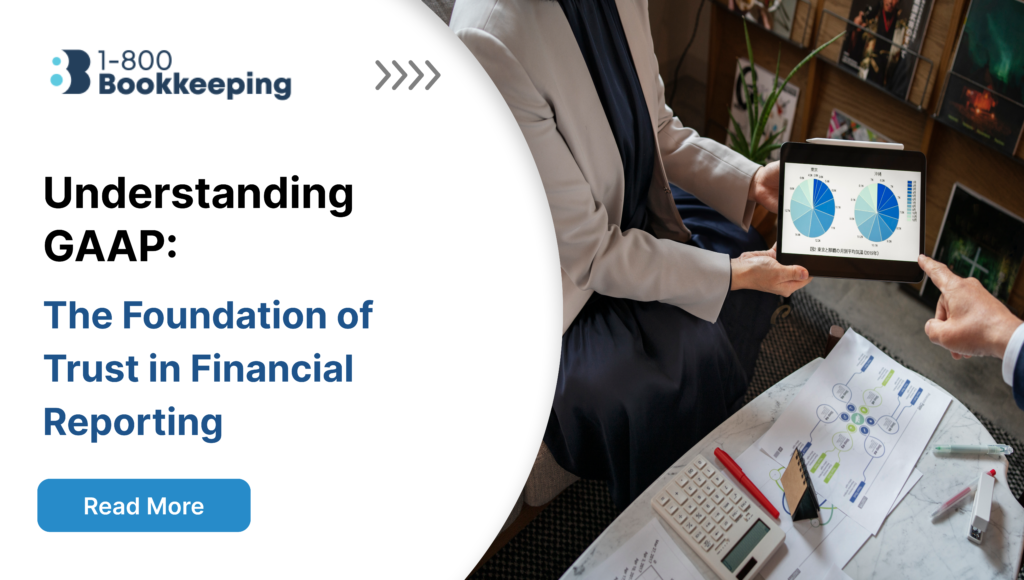Financial statements are the foundation for making informed decisions in the financial world. Yet, with a universal language to present this economic data, comparing companies or understanding a single company’s performance over time is possible.
This is where Generally Accepted Accounting Principles (GAAP) come in. As the cornerstone of trust in financial reporting, GAAP ensures consistency, transparency, and reliability in how companies present their financial health. Let’s delve deeper into GAAP and explore its role in fostering trust within the economic system.
What Is GAAP?
Generally Accepted Accounting Principles (GAAP) are a set of accounting standards, rules, and procedures that serve as the bedrock of financial accounting and reporting in the United States. Established by the Financial Accounting Standards Board (FASB), these accepted accounting principles ensure consistency, comparability, and transparency across different organizations’ financial statements. In essence, GAAP is the language that reliably and consistently communicates companies’ economic reality to investors, creditors, and other stakeholders.
GAAP Compliance: Ensuring Financial Integrity and Credibility
GAAP compliance serves as the bedrock for the integrity and credibility of financial reporting in the U.S. When a company is listed on one of the major stock exchanges such as the New York Stock Exchange or NASDAQ, adhering to the Generally Accepted Accounting Principles (GAAP) is not merely a suggestion—it is a regulatory requirement, enforced by bodies such as the Securities and Exchange Commission (SEC).
However, the influence of GAAP extends well beyond publicly traded corporations. Many private companies, nonprofit organizations, and even governmental entities elect to abide by GAAP standards. This voluntary adherence speaks volumes about GAAP’s reputation as the gold standard for financial reporting. By presenting financial affairs under GAAP, entities of all sizes and structures demonstrate a commitment to transparency and fiscal responsibility. This commitment, in turn, directly affects their ability to attract investment, secure lending, and maintain a solid reputation in the competitive marketplace.
The Accounting Standards Codification (ASC) is at the heart of GAAP compliance, which dictates the proper methodology for recording and presenting a company’s financial data. This codification covers various financial transactions and scenarios, from revenue recognition to the valuation of assets and liabilities. For stakeholders, the assurance that financial statements comply with GAAP is akin to a seal of approval, indicating that they can confidently use this information for making informed decisions.
Do you need help with GAAP compliance? Contact 1800BookKeeping! Our proficient team excels in navigating the complexities of financial reporting, guaranteeing precision and adherence to GAAP standards. Embrace the path to clear and consistent financial statements. Set up a consultation now, and let us convert your accounting challenges into strategic successes!
GAAP vs. IFRS: Understanding the Key Differences
While GAAP is the cornerstone of financial reporting in the United States, the International Financial Reporting Standards (IFRS) serve a similar purpose for over 140 countries globally. These extensive standards are established and maintained by the International Accounting Standards Board (IASB), which, like the FASB in the U.S., seeks to promote transparency, accountability, and efficiency in financial reporting.
The contrast between GAAP and IFRS often comes down to their respective approaches; GAAP is traditionally known for being more rules-oriented and providing precise directives for financial transactions. Conversely, IFRS is principles-based, offering broader guidelines that can be adapted to various situations, potentially providing greater flexibility.
Several vital differences exemplify the GAAP versus IFRS debate. For one, revenue recognition under GAAP is highly detailed, with specific criteria for different industries and scenarios. In contrast, IFRS generalizes revenue recognition principles in a way that can apply universally across sectors. Regarding the balance sheet, GAAP and IFRS may classify items differently, affecting the presentation of equity and liabilities. The treatment of leases is another differing point, with IFRS often requiring that leases be recorded on the balance sheet, while GAAP provides more leeway.
Despite these differences, both GAAP and IFRS share the same ultimate goal: to deliver high-quality, transparent, and comparable financial statements that serve the best interests of the users of those statements. The ongoing discussion and gradual convergence of these standards testify to the global finance community’s pursuit of this shared objective.
The Critical Role of GAAP in Financial Reporting
The importance of GAAP in financial reporting cannot be overstated. By delivering a standardized set of accounting principles and procedures, GAAP enables uniformity in reporting and analyzing financial information. This uniformity is a boon for investors, analysts, and other stakeholders, as it simplifies comparing the economic health and performance of various companies within the same industry or across different sectors.
Companies could craft their financial narratives in countless ways in an economic landscape devoid of GAAP, using diverse accounting methods that obscure actual performance and impede comparison. Such a scenario would erode investor confidence and could lead to suboptimal decision-making, market inefficiencies, and increased risk of financial wrongdoing.
Applications in Financial Analysis
The Indispensable Role of GAAP in Financial Analysis
In the world of finance, accuracy and consistency are paramount. Financial analysts, tasked with evaluating business performance and potential, depend on high-quality, standardized data to conduct their analysis. This is where Generally Accepted Accounting Principles (GAAP) prove crucial. GAAP-compliant financial statements are the bedrock upon which analysts understand a company’s fiscal health and prospects.
Delving into the Balance Sheet
The balance sheet serves as a financial snapshot at a specific time, detailing what a company owns (assets) and owes (liabilities), along with the equity held by shareholders. By adhering to GAAP rules, the balance sheet offers a transparent view of a company’s financial standing, ensuring that assets and liabilities are reported with rigor and consistency. Analysts examine these components to assess liquidity, solvency, and capital structure, enabling them to make predictions about financial stability and growth potential.
Income Statement Analysis
The income or profit and loss statement records a company’s financial performance over a defined period. It presents a detailed account of revenues, expenses, gains, and losses, ultimately leading to net income. Under GAAP, revenue recognition and expense matching principles ensure that the income statement accurately reflects the company’s profitability. Analysts scrutinize this data to understand earnings quality, operational efficiency, and the impact of market conditions on the company’s revenue streams.
Cash Flow Statement Insights
One of the most telling financial reports is the cash flow statement, which outlines the actual cash flow into and out of an organization. It breaks down the cash generated from operating, investment, and financing activities. Under GAAP, the presentation of this statement ensures that analysts can gauge the company’s ability to generate cash, maintain and grow operations, meet financial obligations, and fund future expansions.
Comparative and Benchmark Analysis
One significant advantage of GAAP compliance is that it facilitates comparative analysis. Analysts often compare the financial statements of peer companies within the same industry to determine competitive positioning and industry standards. GAAP ensures that these comparisons are meaningful by standardizing the accounting methods used across companies. Benchmarking against previous performance periods also becomes more reliable under GAAP, providing a historical context for the company’s financial trajectory and enabling trend analysis.
Enhanced Decision-Making
The collective insights gathered from the GAAP-compliant balance sheet, income statement, and cash flow statement are integral to making informed decisions. Investors, creditors, regulatory agencies, and company management rely on financial analysts to interpret this data and provide recommendations. Whether evaluating stock price valuations, considering creditworthiness, enforcing compliance, or making strategic business choices, the high-quality financial information stemming from GAAP adherence is at the heart of sound decision-making.
Who uses GAAP?
The Broad Spectrum of GAAP Users
The Generally Accepted Accounting Principles (GAAP) are not exclusive to any single type of business or organization. Instead, their reach extends across diverse entities operating within the United States, each with unique motives for adhering to these stringent accounting guidelines.
Publicly Traded Companies: Meeting Regulatory Requirements
For publicly traded companies, using GAAP is not just a matter of best practice—it’s a legal requirement mandated by the Securities and Exchange Commission (SEC). By adhering to GAAP standards, these companies commit to producing financial statements that are transparent, consistent, and comparable. This commitment is essential for investors who rely on these financial statements to make informed decisions about buying, holding, or selling stock. Furthermore, credibility with the SEC and the investment community is paramount for these companies to maintain their ability to raise capital and ensure their shares are traded on the stock market.
Private Companies: Attracting Investors and Maintaining Credibility
While private companies are not legally bound to follow GAAP, many choose to do so. By applying GAAP standards, these entities can establish credibility with lenders and potential investors, who often require GAAP-compliant financial statements as a condition for financing. Moreover, private companies anticipating eventual public offering, merger, or acquisition may adopt GAAP to prepare for future financial scrutiny.
Non-Profits: Demonstrating Accountability and Stewardship
Nonprofit organizations use GAAP to ensure they responsibly report their financial status and stewardship of funds. Donors, grantmakers, and government agencies often require GAAP-compliant reporting as a condition for funding, as it demonstrates the organization’s commitment to transparency and accountability. Adherence to GAAP can affect a non-profit’s reputation with stakeholders and the public, impacting its ability to fulfill its mission.
Governmental Organizations: Upholding Public Trust
Governmental agencies at the federal, state, and local levels use GAAP to provide a clear picture of their financial activities and position. For these entities, following GAAP helps uphold public trust and ensures that taxpayer funds are managed according to recognized and reliable standards. While the Federal Accounting Standards Advisory Board (FASAB) provides specialized guidance for federal entities, many state and local governments follow GAAP outlined by the Governmental Accounting Standards Board (GASB).
Bringing Trust and Clarity to Financial Reporting
The widespread use of GAAP among various entities is crucial—it instills trust and clarity in financial data. Investors, lenders, donors, and taxpayers can have confidence that the financial information presented to them is accurate, comparable, and a true reflection of the entity’s economic performance and position. This trust is essential for the smooth operation of capital markets, the allocation of resources in the economy, and the overall integrity and transparency of financial reporting.
The Core GAAP Principles: Pillars of Financial Integrity
The Generally Accepted Accounting Principles (GAAP) represent more than just a set of rules; they embody the principles that ensure financial statements’ transparency, reliability, and comparability. At their core are ten foundational concepts and guidelines that govern the field of financial accounting. Let’s delve deeper into these principles, understanding what they entail and why they are vital for maintaining the integrity of financial reporting.
1. Principle of Regularity
Regularity is the backbone of GAAP, mandating full compliance with all established accounting rules and regulations. This principle requires accountants and financial professionals to adhere strictly to the Financial Accounting Standards Board (FASB) accounting standards and the accepted accounting principles the profession acknowledges. Regularity fosters discipline and order in financial reporting, ensuring all entities follow the same rules.
2. Principle of Consistency
Consistency in accounting practices enables analysts and stakeholders to perform apples-to-apples comparisons across different accounting periods. This principle is the guardian of comparability. It states that once an accounting method is adopted, it should be used consistently from one period to the next unless a change is justified. Thus, consistency allows for observing trends and potential issues over time.
3. Principle of Sincerity
The principle of sincerity goes beyond the numbers; it is an ethical stance. It demands that the entity portray an accurate and fair financial situation. This means financial records and statements should be free from deception and manipulation, reflecting the utmost integrity in presenting the company’s financial health.
4. Principle of Permanence of Methods
Closely related to consistency, the principle of permanence dictates that accounting methods should not be changed arbitrarily or frequently once chosen. This steadiness in approach aids in the stability of financial reports from one period to the next, providing a reliable framework for analysis and decision-making.
5. Principle of Non-Compensation
Non-compensation requires that debts and assets are reported fully without attempting to offset debts with assets. Such transparency ensures that a company’s financial statements accurately depict its solvency and liquidity by avoiding masking liabilities with assets or vice versa.
6. Principle of Prudence
Exercising prudence means adopting a conservative stance in financial reporting. Accountants should not overstate income or asset values or understate expenses or liabilities. The principle of prudence requires caution and moderation, as financial reports should be prepared to weather uncertainties and risks.
7. Principle of Continuity
The continuity principle operates under the going concern assumption—that businesses will continue operating into the foreseeable future. This assumption underpins the valuation of assets and the overall presentation of the financial statements, influencing decisions such as asset depreciation and inventory valuation.
8. Principle of Periodicity
Each financial statement should cover a clearly defined time: monthly, quarterly, or annually. Periodicity allows for routine reporting and regular insight into a company’s business operations and financial standing, which is necessary for stakeholders to make timely and informed decisions.
9. Principle of Materiality
Materiality speaks to relevance; it holds that all significant information—anything that could potentially alter the decisions of those using the financial information—should be prominently and accurately reported. This principle ensures stakeholders have a complete picture without being overwhelmed by insignificant details.
10. Principle of Utmost Good Faith
Utmost good faith requires that all parties involved in financial reporting and transactions act wholly and honestly transparently. This principle is fundamental to maintaining trust among investors, creditors, and the broader market, as it upholds the integrity of business practices and financial reports.
Conclusion:
Understanding GAAP is essential for maintaining transparency, credibility, and trust in financial reporting. These principles, established by the Financial Accounting Standards Board (FASB), ensure consistency and comparability across various organizations’ financial statements. GAAP compliance is a regulatory requirement for publicly traded companies and a voluntary commitment for private companies, nonprofits, and governmental entities seeking to uphold financial integrity and attract investors.
Elevate Your Financial Reporting with 1800 Bookkeeping’s GAAP Expertise
Staying aligned with GAAP (Generally Accepted Accounting Principles) is crucial in business finance. If the intricacies of monthly bookkeeping and GAAP-compliant financial reporting seem overwhelming, 1800 Bookkeeping is your ally. Our seasoned team is dedicated to assisting businesses like yours in regaining financial control. Through meticulous Catch-Up Bookkeeping and consistent monthly services, we ensure your financial reporting is accurate and GAAP-aligned. Connect with us for a free consultation to refine your financial practices and propel your business towards growth.
FAQs:
1. Why is GAAP important in financial reporting?
GAAP ensures consistency, comparability, and transparency in financial reporting, providing stakeholders with accurate and reliable information for making informed decisions.
2. Who uses GAAP?
Publicly traded companies utilize GAAP to comply with regulatory requirements, and private companies, nonprofits, and governmental entities use it to establish credibility, attract investors, and maintain transparency.
3. How does GAAP differ from IFRS?
GAAP is the standard for financial reporting in the United States, while International Financial Reporting Standards (IFRS) are used in over 140 countries globally. GAAP is rules-oriented, providing specific directives, while IFRS is principles-based, offering broader guidelines.
4. What are the core principles of GAAP?
The core principles of GAAP include regularity, consistency, sincerity, permanence of methods, non-compensation, prudence, continuity, periodicity, materiality, and utmost good faith.
5. How does GAAP benefit financial analysis?
GAAP-compliant financial statements are the foundation for economic analysis, enabling analysts to accurately assess a company’s financial health, performance, and potential. This facilitates comparative analysis, benchmarking, and informed decision-making for investors, creditors, and other stakeholders.





